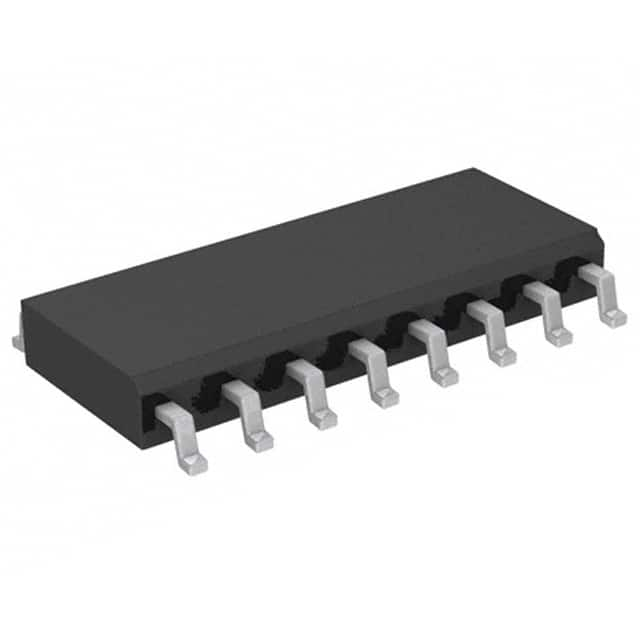Consulte las especificaciones para obtener detalles del producto.

74HCT4052D,118
Basic Information Overview
- Category: Integrated Circuit (IC)
- Use: Multiplexer/Demultiplexer
- Characteristics: High-speed CMOS logic, low power consumption
- Package: SOIC (Small Outline Integrated Circuit)
- Essence: Analog multiplexer/demultiplexer with digital control
- Packaging/Quantity: Tape and Reel, 2500 pieces per reel
Specifications
- Supply Voltage Range: 4.5V to 5.5V
- Input Voltage Range: -0.5V to VCC + 0.5V
- On-state Resistance: 80Ω (typical) at VCC = 4.5V
- Channel-to-channel Crosstalk: -70dB at f = 1MHz
- Operating Temperature Range: -40°C to +125°C
Detailed Pin Configuration
The 74HCT4052D,118 has a total of 16 pins. The pin configuration is as follows:
__ __
A1 |1 \__/ 16| VCC
A0 |2 15| S0
EN |3 14| S1
GND |4 74HCT 13| INH
OUT |5 4052D 12| Z
IN |6 11| B
NC |7 10| C
NC |8 9| D
----------
Functional Features
- Analog multiplexing and demultiplexing of signals
- Two independent 4-channel multiplexers in a single package
- Digital control for channel selection
- Low power consumption
- High-speed operation
Advantages and Disadvantages
Advantages: - Compact size due to integration of two multiplexers - Low power consumption makes it suitable for battery-powered devices - High-speed operation allows for efficient signal processing
Disadvantages: - Limited number of channels (4 per multiplexer) - Requires external control signals for channel selection
Working Principles
The 74HCT4052D,118 is an analog multiplexer/demultiplexer that allows the selection of one of four input channels to be routed to a single output. The digital control inputs (S0 and S1) determine which channel is selected. When the enable input (EN) is high, the selected channel's input is connected to the output pin (Z). The INH pin can be used to disable all channels simultaneously.
Detailed Application Field Plans
The 74HCT4052D,118 finds applications in various fields where analog signals need to be selectively routed or demultiplexed. Some common application areas include: - Audio and video signal routing in multimedia systems - Data acquisition systems for selecting different sensor inputs - Communication systems for switching between multiple channels - Test and measurement equipment for signal routing and switching
Detailed and Complete Alternative Models
- CD4052BE: Similar 4-channel analog multiplexer/demultiplexer from Texas Instruments
- MC14052B: Dual 4-channel analog multiplexer/demultiplexer from ON Semiconductor
- HEF4052BP: CMOS dual 4-channel analog multiplexer/demultiplexer from NXP Semiconductors
These alternative models offer similar functionality and can be used as replacements for the 74HCT4052D,118 depending on specific requirements.
Word count: 399 words
Enumere 10 preguntas y respuestas comunes relacionadas con la aplicación de 74HCT4052D,118 en soluciones técnicas
Sure! Here are 10 common questions and answers related to the application of 74HCT4052D,118 in technical solutions:
Q: What is the function of the 74HCT4052D,118? A: The 74HCT4052D,118 is a dual 4-channel analog multiplexer/demultiplexer IC. It allows for the selection of one of four input channels to be routed to the output.
Q: What is the operating voltage range of the 74HCT4052D,118? A: The 74HCT4052D,118 operates within a voltage range of 2V to 6V.
Q: Can the 74HCT4052D,118 handle both analog and digital signals? A: Yes, the 74HCT4052D,118 can handle both analog and digital signals, making it suitable for various applications.
Q: How many control pins does the 74HCT4052D,118 have? A: The 74HCT4052D,118 has three control pins: S0, S1, and OE (Output Enable).
Q: How do I select the desired input channel using the 74HCT4052D,118? A: The input channel selection is done by setting the appropriate logic levels on the S0 and S1 control pins.
Q: Can the 74HCT4052D,118 handle high-frequency signals? A: Yes, the 74HCT4052D,118 has a wide bandwidth and can handle high-frequency signals up to several MHz.
Q: What is the maximum ON resistance of the 74HCT4052D,118? A: The maximum ON resistance of the 74HCT4052D,118 is typically around 100 ohms.
Q: Can I use multiple 74HCT4052D,118 ICs together for expanding the number of channels? A: Yes, you can cascade multiple 74HCT4052D,118 ICs to expand the number of input/output channels.
Q: Does the 74HCT4052D,118 have any built-in protection features? A: Yes, the 74HCT4052D,118 has built-in ESD (Electrostatic Discharge) protection diodes on all inputs and outputs.
Q: What are some common applications of the 74HCT4052D,118? A: The 74HCT4052D,118 is commonly used in audio/video signal routing, analog/digital multiplexing, data acquisition systems, and communication equipment.
Please note that the answers provided here are general and may vary depending on specific datasheet specifications and application requirements.

